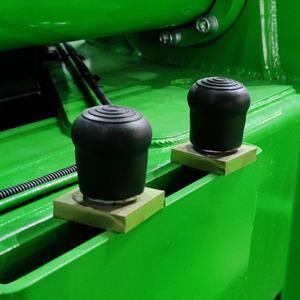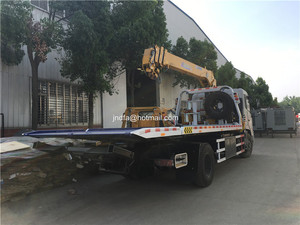Types of Towing Mobile Cranes
A towing mobile crane is a lift truck belonging to the group of cranes that possess high lift capacity as well as versatile lifting abilities. A towing mobile crane is towable, meaning it can be towed behind a vehicle and transported to various locations without the need for specialized transport equipment. It is also commonly known as a travel trailer crane. The cranes are portable and often used in remote or hard-to-reach areas where traditional cranes cannot be easily transported or where onsite setup is limited and space availability is small.
Given below are some variants of a towing mobile crane:
-
Towing service truck crane:
This mobile tow truck crane combination is most commonly used for accidents or vehicle breakdowns. Equipped with a flatbed truck or trailer that has a crane attached to it, it can easily transport a vehicle. It utilizes the crane to lift the vehicle onto its flatbed and then use its towing capacity to transport the vehicle to a repair facility or designated location.
-
Travel trailer crane:
A travel trailer crane is a towable mobile crane that is often used in the construction industry but can also be found camping or in RV communities. Equipped with an RV or camping truck, it is commonly used to assist in lifting heavy items in a construction facility, providing a cost-effective and flexible solution for lifting heavy loads without the need for a specialized towing vehicle.
-
Pick up truck with mobile crane:
One of the most used and popular combinations is a mobile crane attached to a pickup truck. As stated before, the additional mobility and versatility it provides make it ideal for small to medium-sized lifting tasks.
Moreover, the lightweight of the mobile crane allows for easy attachment and detachment from the pickup truck. This makes it a very convenient option. Whether it is at a construction site, or farm, or undertaking a repair or maintenance task, a mobile crane coupled with a pickup truck is bound to provide ease in the lifting of heavy items or equipment.
Towing mobile crane specifications & maintenance
- Load capacity: This capacity may differ significantly depending on the crane model. For example, the capacity could be from 2 to 8 tons for small cranes, usually measured at a distance of up to 3 meters from the center of the crane. Some models may even have a capacity of up to 10 tons (usually larger models).
- Height, reach, and boom length: Another feature that distinguishes different models is the reach and height they can achieve. They range from 10-60 meters, and the boom length can vary from 12 to 45 meters. The boom is the arm of the crane that extends to lift and move loads.
- Power source: The power source and type are significant characteristics. Mobile cranes are often powered by diesel engines, but hybrid or electric options may be available for some models.
- Stability features: These are vital factors in safety and performance. Such as outrigger types, lengths, and positions; the rated capacity chart (with outrigger information); the crane's ability to level on slopes; other stability features like anti-two block or load moment indicators; etc.
- Transmission system: It may be hydraulic or mechanical transmission, including different parts like axles, clutches, differentials, and final drives.
- Gross weight: The weight of the crane itself, as well as those of additional accessories like counterweights, dollies, etc.
- Additional accessories: These may include counterweights, rigging, whips, and other items used to secure the load and ensure safety while towing.
Regular maintenance and servicing of towing mobile cranes can prevent many accidents and failures. Regular inspections according to the schedule are the keys. Inspections should be routine every few months, systematic, and thorough, covering all parts of the crane.
Operators and other people must pay attention to warning signs, sounds, and sensitive parts when using the towing mobile crane. If the performance suddenly changes, or there is a malfunction or failure, they must stop using it and then check and repair it.
With the rapid development of the mobile crane market, advanced technology has been integrated into the design and manufacturing processes, thereby enhancing both their operational efficiencies as well as safety standards. For example, telematics systems are now being adopted by some manufacturers which allow remote monitoring of parameters such as location, speed, load capacity etc., thus enabling real-time tracking & management. Additionally, more & more cranes are equipped with anti-collision devices or automated telescopic controls that help prevent accidents caused due to human error while simultaneously making it easier to operate these machines.
Scenarios
- Construction sites: On various construction sites(many of them remote) around the world, towing cranes are often used to lift heavy materials such as steel beams, prefabricated components, and heavy equipment. Their mobility is particularly important in large construction areas where materials must be moved from one location to another.
- Infrastructure projects: In addition to regular construction sites, towing cranes are also frequently used in infrastructure projects such as road construction and bridge construction. They are often used to install scaffolding, piers, and crossbeams. Their mobility allows them to adapt to different work faces quickly, which is important for the timely progress of the project.
- Wind power industry: The wind power industry has seen rapid development in recent years, and towing cranes play a crucial role in it. These cranes are used to assemble wind turbines, particularly their high towers. Thanks to their easy mobility, they can quickly adapt to different installation locations.
- Logistics and transportation industry: In the logistics and transportation industry, towing cranes are also frequently used. They can be used to load and unload containers and heavy goods, mount and dismount equipment, and more. Their mobility and flexibility are especially important in ports, freight yards, and assembly lines.
How to Choose a Towing Mobile Crane
When purchasing a mobile towing crane for business operations, several factors, such as demand, supply, stability, locality, lifting capacity, hitch type, serviceability, cost, and compliance with local regulations and safety standards, should be taken into consideration.
- Demand, Supply, and Stability: It is important to study the demand and supply for mobile tow cranes in a particular area. Identify the existing competition, take a look at what types and qualities of cranes are being offered, and analyze the stable demand for mobile tow cranes, taking into account local industries that require heavy lifting. This will help to find a profitable niche market where customers have pulling mobile crane needs that are not currently being met by the competition.
- Lifting Capacity and Locality: It is of great importance to determine the lift capacity of towing cranes that is needed by the customer base. Make a thorough investigation into the types of industries that use mobile cranes regularly and their standard required lifting capacity. Additionally, since mobility is one of the major advantages of a mobile crane, it is extremely important for a crane to be able to travel to and operate in different locations efficiently. Make sure that the towing mobile crane can handle jobs in the kinds of environments where businesses usually work, like rough outdoor spaces or tight indoor areas. Choose a crane adapted for the particular places, terrains, and workspaces of a company's construction sites. For example, cranes with off-road tires might be best for rural areas with no paved roads.
- Hitch Type and Serviceability: The towing mechanism of the mobile crane is also important. The type of hitch the crane uses must match the tow vehicle's hitch system, so it can be safely and easily connected. Common hitch types include pintle hooks and standard hitch balls. Furthermore, when buying a mobile towing crane, it is advisable to select one that is easy to service, repair, and maintain. Regular equipment maintenance is vital for safety and productivity, while easily accessible service points and user-friendly design streamline maintenance tasks.
- Cost and Compliance: The cost of mobile cranes varies greatly, so it is important to choose those that have primary features and specifications to take the business's budget and target customer base into consideration. Additionally, it is important to know how the towing mobile crane is made so that it meets various international regulations. Be aware of the prescribed safety features, like system overload sensors and emergency shut-off switches, and ensure that the crane chosen has these. Compliance with standards is essential for the safety of employees and the proper functioning of the equipment.
Q&A
Q1: What is a towing crane?
A1: A towing crane is a type of mobile crane that is towed by a vehicle or trailer for transportation. It has the ability to lift and move heavy loads by itself, being set up quickly at the location of work.
Q2: What is the difference between a crane and a mobile crane?
A2: A mobile crane is a type of crane that can move and travel under its own power. Unlike static cranes, which are anchored to the ground or fixed at a location, mobile cranes can be driven to different locations without the need for disassembly.
Q3: What are the benefits of towable cranes?
A3: The advantages of towable cranes include portability, easy setup, versatility, cost-effectiveness, and safety.
Q4: What are the limitations of towable cranes?
A4: The limitations of towable cranes include load capacity, reach and height, terrain limitations, as well as stability and lifting power.





































































































































































































